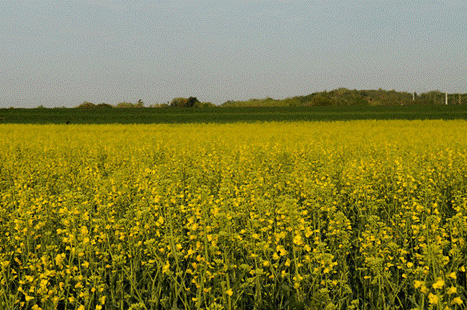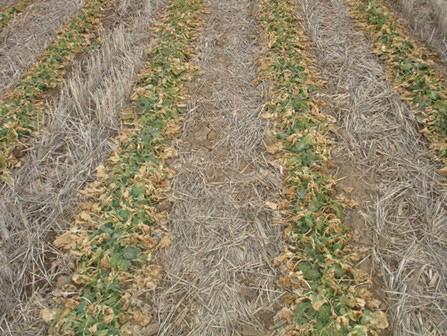Winter-hardy canola varieties now make production possible across much of Kansas. When planted at the right time into good soil moisture, canola has the best chance to establish strong fall growth and survive the winter.

Deciding when to plant canola this fall may be challenging because soil moisture in the planting zone is adequate to variable across the state. High August temperatures and less frequent rainfall patterns have parts of the state lacking in topsoil moisture. The planting window for winter canola arrives in Kansas by early September. As the planting window closes, consider all the risk factors for planting winter canola too late. Getting a good fall stand is one of the most important steps to producing a successful crop.
This article covers three key areas for getting a successful start: variety selection, site selection, and seedbed preparation. A companion eUpdate article addresses other management considerations such as seeding date, rate, row spacing, fertility, and pest management.
Variety Selection
Choose varieties based on winter survival, yield, oil content, herbicide tolerance, disease resistance, maturity, lodging susceptibility, and shatter tolerance. Winter hardiness should be the top priority in new production areas.
Producers have the option of selecting either open-pollinated varieties or hybrids.
Open-pollinated varieties: Common in the southern Great Plains; reliable overwintering and high yield potential. Roundup Ready options are available for broad-spectrum weed control.
Hybrids: Larger seed size, vigorous growth, and high yield and oil potential when resources are not limiting. Clearfield herbicide tolerance is available in some hybrids.
Varieties tolerant to sulfonylurea (SU) herbicide carryover can be used after crops treated with products like Finesse, avoiding long plant-back intervals. Some Roundup Ready varieties also have SU carryover tolerance.
Planting two or more varieties with different maturities can spread harvest timing and reduce risk. Consider pairing a proven variety with a new one to evaluate performance.
Site Selection
Canola grows on a range of soils but performs best on well-drained, medium-textured soils with a pH between 5.5 and 7.0. Correct low pH with lime before planting. Avoid poorly drained or waterlogged sites. Liming should be considered when soil pH is less than 5.5.
Be mindful when planting canola following crops like sunflower, soybean, alfalfa, or cotton. These crops share similar diseases with canola. Continuous canola is not recommended, and it is not insurable. Rotate with grass crops (wheat, corn) to minimize disease risk.
Canola will perform best when adequate time is given after the preceding crop to allow for soil moisture recharge and weed control, and where there is adequate time to get the canola planted early enough to help the plants survive over winter.
Avoid fields with heavy winter annual broadleaf weed pressure if possible. If planting in these conditions, consider a Roundup Ready variety. Grassy winter annual weeds are easily controlled by using clethodim, quizalofop, or sethoxydim in conventional canola, or by using the Roundup Ready or Clearfield canola systems. Be aware of herbicide history - winter canola is sensitive to Group 2 and triazine herbicide carryover, which may require 18 months or more before planting. A companion eUpdate article covers herbicide carryover restrictions in more detail.
Seedbed Preparation
Because of its small seed size, a properly prepared seedbed is critical for successful canola establishment. Open-pollinated varieties typically range from 100,000 to 125,000 seeds per pound, and hybrids range from 70,000 to 100,000 seeds per pound.
A level, firm seedbed with adequate moisture within the top inch is preferred. A seedbed with many large clumps results in poor seed placement and seed-to-soil contact. An overworked seedbed may be depleted of moisture and will crust easily, potentially inhibiting emergence. In addition, this could promote deep placement of the seed.
If using tillage, perform the most aggressive tillage as early as possible, with each succeeding tillage operation being shallower than the last. Incorporate fertilizer and herbicide with the last tillage operation. Some producers perform one aggressive tillage operation as early as possible and then control newly emerged weeds chemically. Planting into this “stale” seedbed will help ensure adequate moisture for establishment.
Tips for no-till planting
No-till planting is an option, and some long-term no-till producers have grown canola successfully using this practice (Figure 1). With proper settings, no-till planting can result in very good stands. However, maintaining stands over the winter can be difficult with low soil disturbance in heavy residue cover. This challenge has been overcome by burning surface residue immediately before planting, removing the residue (i.e., baling), vertical tillage, or using a more aggressive residue manager that removes residue from the seed row. Research in south central Kansas indicates that even with good winter survival, no-till canola yields under heavy residue were lower than where residue was burned or where tillage had been performed.

Figure 1. Overwintering canola established under no-tillage in 30-inch rows in southwest Kansas. Photo by Mike Stamm, K-State Research and Extension.
Ensure that drills and planters are properly set, and consider using a setup that creates a more disturbed seed row. Using a high-disturbance opener (such as a coulter, residue manager, or hoe-type opener) in no-till can improve winter survival and result in yields comparable to those obtained in tilled fields.
Weeds must be controlled chemically, mechanically, or with a combination of both methods prior to planting because canola seedlings are not competitive with established weeds.
Additional Resources
- 2024 National Winter Canola Variety Trial: https://bookstore.ksre.ksu.edu/item/2024-national-winter-canola-variety-trial_SRP1192
- Great Plains Canola Production Handbook. Contact your local Extension office for a copy or download it online: https://www.bookstore.ksre.ksu.edu/pubs/mf2734.pdf.
- Canola Growth and Development poster: https://www.bookstore.ksre.ksu.edu/pubs/MF3236.pdf.
Mike Stamm, Canola Breeder
mjstamm@ksu.edu